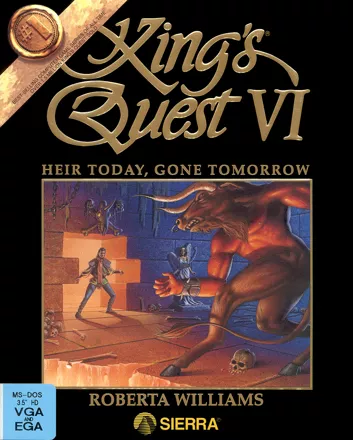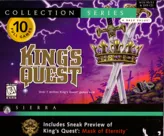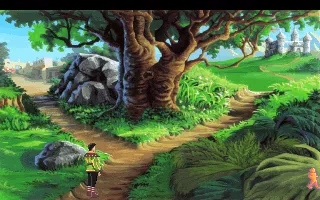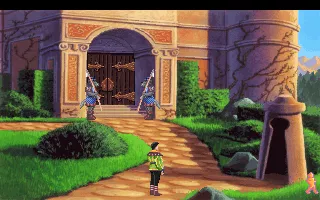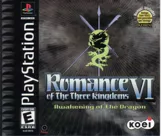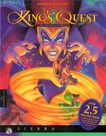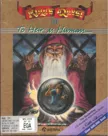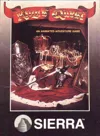King's Quest VI: Heir Today, Gone Tomorrow
Description official descriptions
For months Prince Alexander of Daventry has shut himself away from the world, thinking only of Princess Cassima, who he met while imprisoned in the previous game. Eventually he can take it no longer, and he hires a ship to search for the Land of the Green Isles located on the edge of the world. After months of searching he finally sets sight upon the island kingdom, only for a freak storm to strike the ship, destroying it and leaving him the only survivor. His troubles are far from over, however, as he soon finds out that the King and Queen have passed away, the Greens Isles are on the brink of war, and his beloved Princess Cassima may even be held prisoner by the royal vizier.
Like its predecessors in the series, King's Quest VI: Heir Today, Gone Tomorrow is a third-person puzzle-solving adventure game. For Alexander to save the Isles, he must travel between the Land's four magical islands, each based on myth and fables, and encounter people and strange beasts that will either help or hinder him. Alexander must be careful as well, because, as with all the King's Quest games, poor choices or missteps will often prove fatal for the Prince. Puzzles are solved linearly, although late in the game there are two completely different paths to take to reach the final confrontation. Like the previous game, actions are performed using a point-and-click interface with icons that represent verbs ("walk", "examine", "use", "talk", etc.).
The CD-ROM version of the game includes both DOS and Windows versions, full speech, a pre-rendered introduction, and the Girl in the Tower theme song.
Spellings
- 國王密使 VI:希望之旅 - Traditional Chinese spelling
Groups +
Screenshots
Promos
Credits (DOS version)
39 People (37 developers, 2 thanks) · View all
| Written & Designed by | |
| Produced by | |
| Directed by | |
| Art Designer | |
| Composer | |
| Text & Dialogue | |
| Senior Artist | |
| Team Artist | |
| Senior Programmer | |
| Sound | |
| Team Programmer | |
| Additional Music | |
| Quality Assurance | |
| Additional Sound Effects | |
| [ full credits ] | |
Reviews
Critics
Average score: 83% (based on 26 ratings)
Players
Average score: 4.0 out of 5 (based on 162 ratings with 11 reviews)
An entertaining game, with some problems
The Good
(First of all, a disclaimer: I am anything but a diehard "King's Quest" fan. The only games in the series that I have played is this and "King's Quest VII".)
"King's Quest VI" casts the player in the role of Prince Alexander of Daventry, shipwrecked on the island where his lost love, Princess Cassima, lives. The object of the game is to get in contact with Cassima and save her from the dark machinations of a Grand Vizier (of course; never trust the Grand Vizier). I wouldn't say that this is a particularly original storyline, but it does have a serious, emotive appeal, even if one isn't a big fan of romance. The plot also develops nicely throughout the game, as Alexander travels to the other islands ruled by Cassima and delves deeper into the intrigues.
The writing is good for a computer game. It does get melodramatic in places, but most of the time the dialogue and narrative holds up, and the object descriptions are concise and useful.
Graphics-wise, the game is little short of excellent. Some character sprites are a bit undistinguished, but the backgrounds are consistently beautiful. Some of the locations (the forest, for example, or the top of the Sacred Mountain) will stay with me. The cutscenes are also outstanding (particularly the Oracle).
The sound effects are very real-sounding. (Unfortunately, the sound on my computer gave in around this time, so I played the second half of the game with no music.)
The H.P. Lovecraft reference got a big "YAY!" from me.
Controls are very good, and the invisible interface must have been quite groundbreaking for the time.
The puzzles are varied. While I liked some better than others, on average they were quite good. I particularly enjoyed the showdown with the Five Gnomes and the various spell ingredients. The way you use the two old coins is great as well.
More impressive than writing, graphics or puzzles, however, is the very scope of the game. The world is big, new areas being unlocked is the best incentive to keep playing. Usually, they don't disappoint. On a related note, the two different (but both successful) endings is a brilliant innovation that I haven't seen very often in old, or for that matter new, games. (OK, "Maniac Mansion" did it first, but its alternative endings were on a smaller scope.) When I got one of the endings, I immediately replayed it to get the other one.
The Bad
The fairy-tale simplicity of the plot and characters didn't allow much depth. The characters are flat, though not unrealistic. The only people in the game I actually felt for were all in the Land of the Dead, which is probably significant.
A slight problem, but still a problem: the two mutually exclusive endings, as I said above, were a brilliant idea, and great in execution - but it still felt rather evident that one wasn't as good (conclusive, extensive) as the other. In consequence, the shorter ending felt less satisfying than the other.
(Only after reading the reviews on this site did I try to listen to "Girl In The Tower" online. I can now say: I'm glad I missed it in the game. That song wouldn't even be shortlisted for the Eurovision.)
There are two people named Ali in this game. This caused me confusion.
There is very little thematic coherence. Early in the game, I went to the town and the castle, and expected a serious fantasy game set in an "Arabian Nights"-like milieu - rather unusual, as far as games go. Unfortunately, the faux-Arabic setting was confined to the Island of the Crown. The other significant places in the game were disappointingly based on North European fairytales, Lewis Carroll-inspired nonsense stories, British druid lore, or Classical myth. Quite apart from the lack of unity (I can't believe how a couple of adjacent islands could be so dissimilar in culture), it also feels disappointingly unoriginal. I am certain Ms Williams could come up with her own plotlines, rather than ransacking unconnected myths and fairytales.
On a related note, there is some inappropriate comic relief in wrong places. One death scene, for example, taking place in one of the best-written and moodiest parts of the game, is unbearably cartoonish.
In the matter of gameplay, "King's Quest VI" have some features that are not as popular today. You can die by performing explicitly stupid actions, which I don't mind. You can also die by, for instance, accidentally clicking next to a block you're stepping on to, causing Alexander to jump off. You can render the game unwinnable, I am pretty sure, by failing to pick up something in a place you can only visit once, or by entering the Catacombs without the right equipment (however you are meant to know what the right equipment is). Make sure to save before doing something that might be risky.
Objects simply turn up in places, for no other reason than that the plot demands them, and this happens several times. In quite a few places, the answer to: "How do I find [object] that I need for this puzzle?" is simply: "Go back to [place] and it'll be there." I give them credit for the fact that the objects turn up in places where they could realistically be (a teacup on a coffee table, for example). But it breaks immersion.
Not so much so, however, as an unfortunately central puzzle near the end (the one involving the "drink me" potion and the lamp). It ranks among the worst adventure game puzzles I know. I can't start to explain what's wrong with it, but think about this: why does Alexander perform this admittedly clever action? So that Alhazred will think he's dead and be off his guard? (Presumably, though this is never addressed.) What is accomplished, however, is that the player gets vital information through a cutscene, and then makes Alexander act on this, even though he hasn't got the information. The creators were aware of the weirdness of this (note Alexander's dialogue when handing over the lamp), which means that they knew how stupid it was, and didn't do anything about it.
Yes, there is one thing I hated more than that puzzle, and that was the Island of the Internal Copy-Protection. Let me explain what an idiotic idea this was. If a company is worried about pirated copies of a game, they should put the copy-protection bit before the start of the game, where it belongs. The only thing they accomplish by putting copy-protection questions INSIDE the game, dressed up as puzzles, is to make themselves look like morons.
I may serve as a test case, since I bought the game in a classics edition, where the manual was a very slim thing containing only an explanation of the controls and the key of the Language of the Ancients. When I got to the Island of the Sacred Mountain, the following happened: I solved the first puzzle more or less by trial and error, solved the second puzzle after much thinking, and then I was stuck. Eventually, I looked the solution to the third puzzle up on the Internet, and it turned out to be... four different symbols that did not make up any word, sequence or pattern I could understand. Why? Because that's how the creators of the game ordained, and hey, it said so in the original manual. The rest of the puzzles I solved by trial and error, again. By the time I got to the trapped flagstones in the Catacombs, I simply got by by save-and-restore.
To clarify to any budding programmers reading this review: puzzles in a game can be based on pure logic (like certain types of riddles), or they can follow the game-world's internal logic (give the pecan chocolates to the guy who likes them and get information in return), or they can be based on common knowledge (garlic kills vampires). Most of the Sacred Mountain puzzles conformed to nothing of the above. They weren't out of place in themselves (everyone knows that ancient civilisations loved to surround themselves with puzzles and traps, or you haven't watched "Indiana Jones"), but they were not solvable unless the player had the manual. And even then, they made no sense.
Might I add, the "real" manual (when I eventually found it) was one of the worst examples of such that I've read. It explained everything: not just the copy-protection puzzles, which deserved it, but also, for instance, the identity of the people of the Sacred Mountain, which would have been much better left for the player to find out. What is the point of putting the player in a "marooned on an unknown island" scenario if you're going to provide him or her with all the information about it?
The Bottom Line
In spite of my whining, "King's Quest VI" is a beautiful, well-written game with a large and exciting (if somewhat stale) fantasy world, a decent plot and many twisty puzzles. I just wish it could have been less heavy on the stuff I didn't like.
DOS · by Christina Nordlander (24) · 2005
Classic adventure with a pretty facelift
The Good
King's Quest 6 plays as a classic fairy tale might. The plot is unusually complex and rich for the series, thanks to contributions by Gabriel Knight writer/designer Jane Jensen, who's design methods complemented Roberta Williams' perfectly in this installment.
The plot itself has been done before, even in the series (Prince Alexander sets out to rescue his love after seeing her trapped in a tower through an enchanted mirror), but the flair and atmosphere with which the game executed is phenomenal. Charmingly quirky at times and dark and mysterious at others, the game provides brain-teasing puzzles set against a vibrant environment that ranges in influence from Arabian Knights to Alice in Wonderland.
Beauty and the Beast's Robbie Benson does a solid job as the protagonist, and its ironically funny to hear him interact with the game's own equivalent of Beast. This was also the first entry in the series to offer multiple solutions to solve the game, one of which permitted you to skip a good 1/3rd of the game (this component was half-heartedly featured in the series' next installment as well).
The Windows version features newly-detailed character portraits that are a nice, if unnecessary, addition.
The Bad
Despite the multiple paths, the game's replayability factor is somewhat limited. Some of the puzzles are unnecessarily frustrating (this is during a time when Sierra cruelly worked anti-piracy techniques into the game's structure, frustrating those who owned legitimate copies), requiring you to save often and reattempt all-too-often. It's also very easy to miss something or make a mistake that will have fantastically bad and unforeseen consequences for the future. One such puzzle involves descending to the underworld to save the love interest's parents, only to discover that if when you get back, you forgot to pick up water from the River Styx, you are stuck without recourse and must load from a previous save. There are several instances like this where even people who have played the game multiple times before (myself included) can easily get stuck.
The Bottom Line
If you're an adventure gamer, you've already played this, and I don't have to say anything. If you're just getting into the series or the genre, this is an essential. A true classic.
Windows 3.x · by jTrippy (58) · 2007
King's Quest II gets ramped up a notch
The Good
King's Quest VI was the first King's Quest game that I ever played, and this was back when I got my first PC. I only played the second game years later. KQ2 was released in 1985 and had you rescue a damsel in distress who was held captive in a quartz tower. Sierra decided to revisit the same theme seven years later, but this time round they created a much bigger game, with more puzzles, great graphics, a delightful soundtrack, and lots of dialogue.
Roberta Williams was the sole designer for the first five games, but that was to change during the production of the sixth game. Roberta teamed up with master storyteller Jane Jensen who was new at Sierra at the time. The KQ6 hint book has a lot of detail on the making of the game, and it's worth a read. Jane would later go on to create the Gabriel Knight series.
This game begins right where King's Quest V left off. For those who haven't played it yet, Cassima was also in the fifth game, working as a servant under Mordack. King Graham, along with his friend Crispin, helped her get back to the Land of the Green Isles (“the Green Isles”). Before this happened, Alexander develops a crush on her and said that he would visit her sometime. Alexander was true to his word and sets sail to the Green Isles. While en route, a storm arrives which leaves Alexander shipwrecked on the Isle of the Crown, which happens to be the same island where Cassima is being held.
This is all featured in the game's introduction, and there are different versions of this, depending on whether you have the CD-ROM or disk version. The introduction to the disk version was okay, but I was more impressed with the CD-ROM version's. It is 50mb long and just stunning, and you can see a lot of effort was put into it
KQ6 is, in some ways, similar to King's Quest III. You see, besides playing Alexander again, you use a magic map, but you are given the freedom to teleport to different areas (in this case, the islands), and therefore are not restricted to just exploring the one place. Every area has a certain theme. The Isle of the Crown has an Arabian Nights theme, while the Isle of the Sacred Mountain is based on classical mythology. Another similarity between the two games is the fact that depending on the path you take, you may or may not be required to prepare and cast spells. The easy thing about this is that you only have to put the ingredients together and use a spell book to cast the spell, rather than typing the incantation.
What makes KQ6 stand out from the rest of the series is the way you can solve puzzles differently, as well as letting you choose the route that will get you inside the castle. I was more satisfied with going down the hardest route, which offers more locations and slightly harder puzzles. There are also several variations to the ending – mentioned in Peter Spear's “King's Quest Companion” - that are worth replaying the game for.
There are many ways to solve KQ6, using alternate solutions for some situations that you will face, and you will be awarded more points if you happen to take the best route. Your end goal is to get inside the castle, and there are multiple ways that you can get inside, and more points are also awarded if you choose to take the difficult path in. The multiple solutions make KQ6 highly replayable.
Like KQ5 before it, the game uses 256-color VGA graphics. The hand-drawn backgrounds in KQ6 are much better, and the environments that you walk around in are great, ranging from beaches to gardens. The characters that you encounter are well-drawn, and I can definitely relate to some of them. the portraits are good as well, and the lip-synching is excellent. Like all Sierra's games that uses their newer SCI engine, the icon-driven interface is quite colorful, although I didn't like how it looks in the CD-ROM version as it just doesn't blend in. One of the “About” pages (in the Control Panel) give you an overview of the previous King's Quest games, which is ideal for players who never played one of the previous games to go out and buy the game if they are interested.
The soundtrack is well composed, and each piece blending in with what sort of environment you are in. Each bit of music is excellent if you are playing the game with a General MIDI device such as the Roland SC-88. The sound effects are also great with a cartoony effect thrown in for good measure.
The CD-ROM version also featured the “Girl in the Tower” song, well suited to the game's theme. It was written by Mark Seibert, sung by a couple of nobodies, and praised by the majority of King's Quest fans. (Okay, the singers were never credited in the closing credits, so I stand by my statement.) A snippet of the song can be heard in the disk version, and players were encouraged to call their radio station and request its broadcast. Most radio stations refused to play the song, and Sierra was threatened with legal action. This version of the game also includes a video on the making of the game.
I like the humor in the game. There are amusing tidbits on each of the islands you visit, but I found a lot of the humor is triggered when you try to talk to everything you see. And Sierra added a talk icon in the inventory for a reason, and having said that, I enjoyed talking to Rotten Tomato as he has some funny things to say. ("I've got a lawyer, you know. There's some kidnapping laws in this here kingdom.")
There is one point in the game where you have to refer to the “Guidebook of the Land of the Green Isles” that came with the game to solve The Cliffs of Logic, otherwise you won't be able to progress through the game. Not only does it serve as the copy protection for the game, it also provides some useful information about the Green Isles and its flora and fauna.
The Bad
So Sierra made the effort of making the introductions of both disk- and CD-based versions different from the rest of the game. But why didn't they just bother doing the same thing to some parts of the game, what other companies did to their interactive movies. Sierra may have limited its cut-scenes to fit its files on a single disk, but back in the early 90's, CDs had a 650MB capacity, so there was no reason why Sierra didn't do this, especially to the CD version.
There are always inconsistencies among the voices in Sierra's CD-ROM games. Different actors have played the same role. The voice of Alexander is not the same voice that you hear in KQ6, and the same goes for Cassima, Rosella, and Valanice as well. The characters are played by two different people, and I don't think that's right. There should be the same actor playing a certain character throughout the series, like what Sierra did for Graham.
The Bottom Line
Although KQ6 has the "rescue the princess" theme, it has a much, deeper plot. The game is similar to KQ3, in which the tasks that you did in this game are also repeated here. It is worth getting the CD-ROM version? Yes, because you get to watch the stunning introduction, get to experience some top-notch voice acting, and enjoy some other bonuses. Can Sierra maintain the same quality for the rest of the King's Quest games? Play them and find out.
DOS · by Katakis | カタキス (43091) · 2015
Trivia
Amiga version
The back cover of the Amiga version contains information: "Beautiful graphics in 256 colours or 32 colours (two versions available)." but the game was released only in 32 colours version.
According to KQ VI reviews in Amiga Computing, Amiga Format and Amiga Power magazines Sierra originally planned to release a 256 colours version but decided that 32 colours version looked so good already so they shelved the idea.
The game was ported to the Amiga by Revolution Software, though the company wasn't credited on the box or in the manual. This is why this version uses Revolution's Virtual Theatre engine instead of SCI.
CD version
The CD version of King's Quest VI includes Girl in the Tower , the theme song to the game, composed by Mark Seibertm in full length. A sample of it can be heard on the floppy version for five seconds, then the game urges you to ring up radio stations that was listed in the manual and request it. Also the introduction was also extended in the CD version.
Music
Chris Braymen, the game's composer, quoted a Gregorian chant (Dies Irae) in the theme that plays when Prince Alexander is captured in the Catacombs of the Isle of the Sacred Mountain. It's a famous theme, quoted as well in many classical compositions such as Berlioz' Symphonie fantastique (5th part), in Stanley Kubrick's films The Shining and A Clockwork Orange, and also in Indiana Jones and the Fate of Atlantis (Room of the God Machine).
References
King's Quest VI's villain is named Abdul Alhazred; this name was taken from the work of horror and sci-fi writer H.P. Lovecraft. Abdul was a fictional character (also dubbed ''the Mad Arab'') who wrote the Necronomicon.
Technology
This was Sierra's first adventure game to feature their lipsyncing technology that they got when they bought out Bright Star Technology.
Awards
- Power Play
- Issue 02/1993 – #2 Best Presentation in 1992
Information also contributed by B14ck W01f, B.L. Stryker, game nostalgia and Jiguryo
Analytics
Upgrade to MobyPro to view research rankings!
Related Sites +
-
Game Nostalgia
Provides extensive background info for King’s Quest VI: Heir Today, Gone Tomorrow, pictures of the cast and examples of voice-overs, full credits with shots and info about the design team, demo of the game, specific details about the game, various goodies, all musical themes, shots of every location in the game, video clips, saved games, a list of reviews, including a "nostalgic" review and tech specs. -
Hints for KQ6
These hints will help you solve the game.
Identifiers +
Contribute
Are you familiar with this game? Help document and preserve this entry in video game history! If your contribution is approved, you will earn points and be credited as a contributor.
Contributors to this Entry
Game added by Andy Roark.
Amiga added by POMAH. Windows 3.x added by Mr. Huh. Macintosh added by Terok Nor.
Additional contributors: Adam Baratz, Katakis | カタキス, Jeanne, formercontrib, game nostalgia, Paulus18950, Patrick Bregger.
Game added May 23, 1999. Last modified April 2, 2024.
